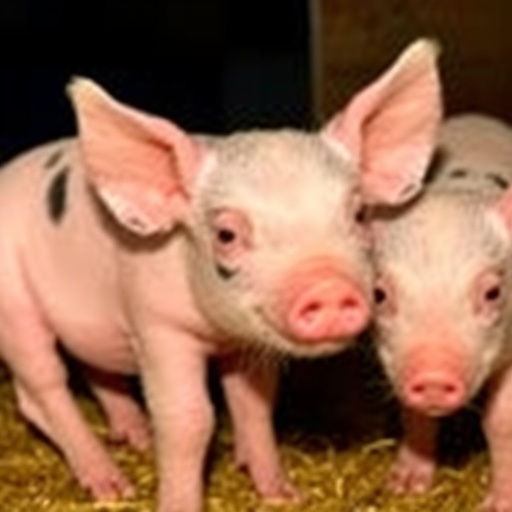In the rapidly evolving field of veterinary science, the significance of understanding cardiovascular health in livestock cannot be overstated. A new study, prominently featuring transthoracic echocardiography, has shed light on the intricate cardiac parameters of growing piglets, highlighting both the methodology and implications for animal welfare and agricultural efficiency. Conducted by a team of experts, this research aims to refine our understanding of cardiac function during the crucial development phases in swine.
The state of the art transthoracic echocardiography (TTE) has emerged as a pivotal tool in assessing cardiac parameters non-invasively. This technique enables researchers and veterinarians to visualize the structural and functional aspects of the heart. Essentially, it allows for real-time imaging, providing valuable insights into heart anatomy, dimensions, and performance metrics without the stress associated with invasive procedures. This is particularly crucial for young piglets, whose cardiovascular systems are still maturing and can easily be affected by stressors.
The study draws attention to the importance of early detection of cardiac dysfunction in piglets. Given that swine farming is a critical component of the global agricultural landscape, ensuring optimal health in these animals directly correlates with productivity and economic viability. By utilizing TTE, researchers have access to a non-invasive method to monitor heart health, enabling them to identify potential issues before they develop into significant health crises.
Piglets, like all young mammals, undergo rapid physiological changes as they grow. Their hearts, adapting to increased physical demands, can experience variations in size, shape, and functionality. A failure to monitor these changes could lead to undetected cardiac issues that may not only affect the health of the individual animals but may also have broader implications for the farming operations as a whole. The research emphasizes the need for regular cardiac assessments to ensure that piglets are meeting their growth potential.
In the study, the authors utilized a cohort of growing piglets, systematically analyzing their cardiac function through TTE. This methodology involved capturing multiple echocardiographic views to comprehensively assess parameters such as chamber size, wall thickness, and cardiac output. The results provided an in-depth look at how these parameters evolve as the animals age, paving the way for constructive comparisons across various breeds and farming practices.
One of the standout findings from the research was the variability in cardiac function between piglets, influenced by factors such as genetics, diet, and environmental conditions. This notion reinforces the idea that a one-size-fits-all approach to piglet care may not be sufficient. Instead, the findings suggest a tailored approach that considers individual animal health and breeding techniques to enhance overall cardiac wellness.
Moreover, the implications of this research extend into the realm of future breeding programs. Armed with enhanced knowledge of the cardiac development phases in piglets, breeders can make more informed decisions to select for traits that promote heart health. This proactive stance could significantly reduce the frequency of heart-related issues in pigs, ultimately supporting the overarching goal of sustainable livestock production.
The integration of advanced imaging techniques like TTE into routine veterinary practice represents a paradigm shift in animal health monitoring. This study serves as a testament to the growing recognition of the importance of non-invasive diagnostic methods in ensuring optimal animal health. Establishing a more profound understanding of swine cardiovascular systems not only enhances animal welfare but also optimizes agricultural returns, demonstrating a responsible approach to animal husbandry.
Furthermore, the research findings are expected to stimulate interest among veterinary practitioners and research institutions alike, inciting discussions around standardizing echocardiographic assessments in clinical settings. Regular implementation of these assessments could serve to elevate the standard of care provided to livestock, emphasizing preventative health measures over reactive treatments.
The enduring importance of research like this lies in its ability to connect scientific understanding with practical applications in the field. As science continues to evolve, sophisticated techniques such as TTE will undoubtedly become integral to veterinary practices, anchoring them in a future that prioritizes animal health monitoring and welfare.
Ultimately, as the agricultural sector faces increasing pressures from economic and ecological challenges, optimizing the health of livestock will play a central role in meeting food production demands. Studies that focus on innovative methodologies like transthoracic echocardiography pave the way for a new era of precision agriculture where wellbeing and productivity become harmonious goals. The advancement of veterinary science stands to benefit significantly from this new frontier of cardiac assessment technology.
In conclusion, the utilization of transthoracic echocardiography in evaluating the cardiac function of growing piglets opens a new chapter in veterinary cardiology. With the combination of technology and a deeper understanding of animal health, the future of swine production looks promising. This research not only enriches the scientific literature but also sets a precedent for future studies aimed at bridging the gap between veterinary science and practical agricultural applications. As we look forward, the lessons learned from this research will inform better practices, ensuring that the livestock sector can thrive while prioritizing animal health and welfare.
Subject of Research: Cardiac parameters in growing piglets evaluated through transthoracic echocardiography.
Article Title: Transthoracic echocardiography for evaluating cardiac parameters in growing piglets.
Article References:
Qasim, A., Contorno, E., Javed, H. et al. Transthoracic echocardiography for evaluating cardiac parameters in growing piglets.
Sci Rep 15, 38300 (2025). https://doi.org/10.1038/s41598-025-22176-y
Image Credits: AI Generated
DOI: https://doi.org/10.1038/s41598-025-22176-y
Keywords: Transthoracic echocardiography, piglets, cardiac health, veterinary science, animal welfare, non-invasive diagnosis, agricultural production, veterinary practice, swine cardiovascular systems.
Tags: animal welfare in swine farmingcardiovascular health in livestockearly detection of cardiac dysfunctionechocardiography in veterinary scienceheart health assessment in pigletsimplications for agricultural efficiencynon-invasive cardiac imaging techniquesoptimizing swine productivity through health assessmentspiglet development and heart functionstress impacts on young pigletstransthoracic echocardiography benefitsveterinary research in swine





